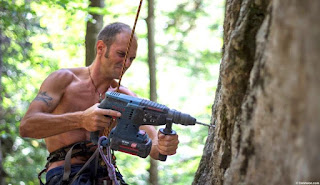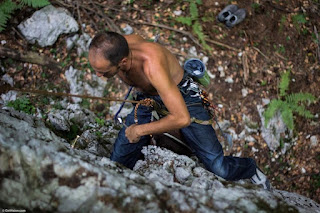How To Build Your Own DIY Climbing Hangboard without Drilling The Wall Above Your Doorway
If you don't like the ebook, no worries. I'll give your money back and you get to keep the book. Guaranteed!
|  |  |  |
Perhaps you've wondered how those sport climbing routes are created.
It's not very complicated actually. The real problems are time and money - the hangers and ring-chains are not cheap. And I guess time is not cheap either.
Bolts? They're affordable alright.
What you need
Among a complete set of climbing gear with ropes, cams, quickdraws, climbing shoes, etc., you need the following specific gear:
- Electric hammer-drill with rechargeable batteries (accu) or on gasoline. We use a Bosch. Hilti is good as well, maybe better.
- Fixe or Faders bolts, hangers and chain rings. You can also improvise belay stations instead of chains.
- Hammer - regular or professional or whatever - something that gets the job done.
Bolting the routes
The process is simple but please note that it's important where you actually place the anchors. Especially the first few and those in the crux. You should think about the safety and metal comfort of the climber who'll be ascending your route.
As for ethics, scroll down to the comments and check out Charles' remarks.
1. Identify a sexy line and find a way to get to the top of the cliff. If this is not possible (on rock towers for instance), you can build an artificial line of bolts just to get to the top. Once you get to the top, you can leave a fixed rope for later access.
2. If there are trees on the cliff, setup a top-rope on a tree. If there are no trees, use pitons or bolt a temporary chain.
3. Rappel down the rope, tie in and climb up your line (top-rope). As you climb, mark with chalk the spots where you'd like the anchors to be. Make sure the bolts are easy to reach from comfortable positions for the climber - basically this means good holds for hands and feet.
4. As you reach the top of the line, ask your belayer to send you the tools (drill and all). Beat the marks with the hammer - look for a solid sound. Never bolt in loose rocks. Clean before bolting. Place the top ring-chain first, then place the rest of the bolts as you're being lowered by your assistant. After each anchor placed, connect your rope with a quickdraw as to be close enough to the wall for the next bolt (and so on until you're down).
5. When the route becomes too overhanging, use cams, stopper nuts, cliff hooks or just add temporary extra bolts to keep you close to the rock.
Celebrate with a rest day (and some beer) after you're done. Then come back with your friends and climb the routes. Ask each of them to grade the lines and do the average (mean) to realistically asses the difficulty of each sport climbing route.
If you're felling pumped, it means that you're working something. :-) And that's how you get better, right?
For any questions or remarks, leave a comment and I'll reply.
You can read a comprehensive guide on the topic (equipping climbing routes) on Escalada.Verticon.ro (Google Translate version from Romanian to English).
Be safe!
Pictures by Sorin Ciribasa - CiriVision.com
Thanks for stopping by! Share this article with your friends.













Thanks for a good article about bolting a sport climbing route. I'd like to add a few points too.
ReplyDeleteBe careful of local ethics. In some areas you should bolt your route on lead only, and not on top rope.
Be careful of local regulations. In some areas you are not allowed to use a power drill, and must use the old fashioned manual hammer drills. In some government lands you must file for permission many months in advance and there are months when certain cliffs are closed for wildlife breeding, etc.
Think before you create a line. Some climbers prefer a line to be aesthetic or have some other redeeming feature. If the line can be safely protected with cams or trad gear, then you should think about leaving it as a trad line.
Consider the area. If there are 200 5.8 or lower routes in that area, it probably doesn't need another low grade route.
In many areas, the people who created the route get to finish it first before others can, but this is a politeness that depends on local ethics, and normally, you put a red ribbon on the first hanger to make sure everyone knows you haven't finished it yet.
This is a good topic, about bolting a sport climbing route. Thanks.
Totally with you there, Charles.
DeleteOur local rules aren't so strict though. We have enough wildlife, enough rocks and not too many climbers.
UK and Germany had very strict rules in certain areas. I liked that and I respect their climbing culture.
Thanks for the tips!
Hay un fallo de principiante al colocar las chapas, estan todas mal orientadas.
ReplyDeletePor lo demas buen trabajo.
Saludos desde el Pais Vasco (España)
:-) Cheers!
Delete